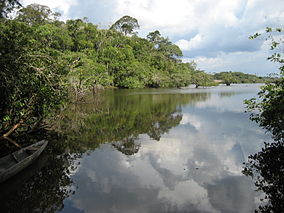- Cuyabeno Wildlife Reserve
-
Cuyabeno Wildlife Reserve IUCN Category VI (Managed Resource Protected Area)
Location  Ecuador
Ecuador
Sucumbíos Province, Putumayo Canton; Orellana Province, Aguarico CantonCoordinates 0°07′00″S 75°50′00″W / 0.1167°S 75.8333°WCoordinates: 0°07′00″S 75°50′00″W / 0.1167°S 75.8333°W Area 6033.8 km² Established 1979 The Cuyabeno Wildlife Reserve (Spanish: Reserva de Producción Faunística Cuyabeno) is a humid tropical rainforest protected zone in Ecuador. It is situated in the Putumayo Canton in the Sucumbíos Province and in the Aguarico Canton in the Orellana Province. It was founded on 26 July 1979. At an altitude of 200– 280 meters, one of the principle objectives of the 6,033.8 square kilometres (2,329.7 sq mi) Cuyabeno Reserve is ongoing conservation of the complex Amazonian ecosystem. The reserve is a complex of rivers, lagoons and floated forest. The protected area is characterized by its high biodiversity and interaction and cooperation between the species inhabiting the area. Its geomorphology is a consequence of the rivers carrying sediment and materials from the Andes, principally by Aguarico River, which is considered as white water due to the sediment it drags raising water levels and therefore ensuring that the river is navigable all year round. It is considered to be one of the most biodiverse sites in the world together with the neighboring Yasuni National Park.
Contents
Characteristics
This is a place of great biodiversity, home of one the greatest wildlife concentration places in the world, both flora and fauna-wise. It is a complex system of rainy formations, 13 small lakes, rivers and tropical wild forests turning this 1,500,000 acres (6,100 km2) into a record of highest level of biodiversity in the world.
Within the tropical rain forest vegetation, there is a rich variety of plants such as palms, bromeliads, Ceibos, heliconia, Macrolobium, wild roses and 60 different orchid species. 12000 different plants have been approximately found inside the wildlife reserve. Many are used by the native Indians medically.
Cuyabeno keeps more than 550 different bird species, more than 350 fish species, including piranhas; a great variety of reptiles such as anacondas, alligators and river turtles. Frequently observed species include various species birds, such as colorful parrots, kingfishers and hoatzins or Amazon eagle, which flaunts its 8-foot (2.4 m)-wide wingspan, and lots of varieties of beetles and poisonous dart frogs as well. Amongst the mammals, the tapir (Tapirus terrestris), freshwater pink dolphins and armadillos can be found.
The river system covers the rivers Aguarico, San Miguel and Cuyabeno and their tributaries. Along the Cuyabeno is a system of 14 black-water lagoons, which in the rains of the lowland rain forest from April to July are formed by floods. They are typical of the rainy season and dry during the dry season from December to March, almost completely.
Due to this wildlife reserve belonging to the National Protected Areas System, very few tour operators are qualified to work in this zone. This is why not so many tourists can be found visiting this zone, making it more attractive to enjoy the nature and its magnificent sounds.
-
Ivory-billed Aracari (Pteroglossus azara), Cuyabeno Wildlife Reserve
Climate
It corresponds to a wet tropical forest, with precipitations between 0.18 to 0.25 cubic inches per year, and humidity ranges from 85% to 95%. The dry season starts from December until March and the rainy season from April until July. There is a moderate rain season in between August and November. The annual temperature oscillates around 25 °C (77 °F)
Ethnology
The Cofans, Sionas, and Secoyas live by the banks of two important rivers, the Aguarico and the Cuyabeno, both affluents of the Amazon. The Siona community lives in the northern part of the reserve, in Puerto Bolivar and along the Tarapuy river.
Shamanism
Siona, Secoya, and Cofan folk healers (locally called "shamans") are respected among other communities in the jungle for to their botanical knowledge.
External links
 Protected areas of Ecuador
Protected areas of EcuadorNational Parks Biological Reserves Limoncocha · GalápagosEcological Reserves Antisana · Arenillas · Cayambe Coca · Cayapas Mataje · Cofán Bermejo · Cotacachi Cayapas · El Ángel · Illinizas · Mache Chindul · Churute MangrovesGeobotanical Reserves Wildlife Reserves Chimborazo · Corazón Island · Cuyabeno · El SaladoWildlife Refuges Pasochoa · Muisne River Mangroves · Santa Clara IslandNational Recreational Parks El Boliche · Parque LagoBinational Parks El CondorCategories:- IUCN Category VI
- Protected areas established in 1979
- Nature reserves in Ecuador
- Sucumbíos Province
- Orellana Province
-
Wikimedia Foundation. 2010.

